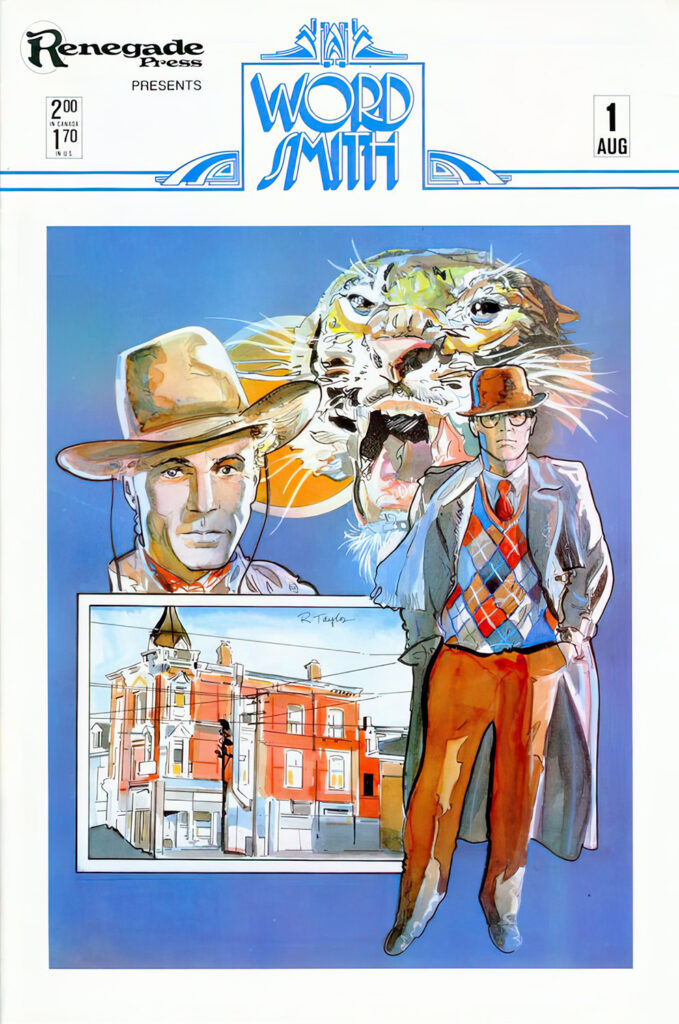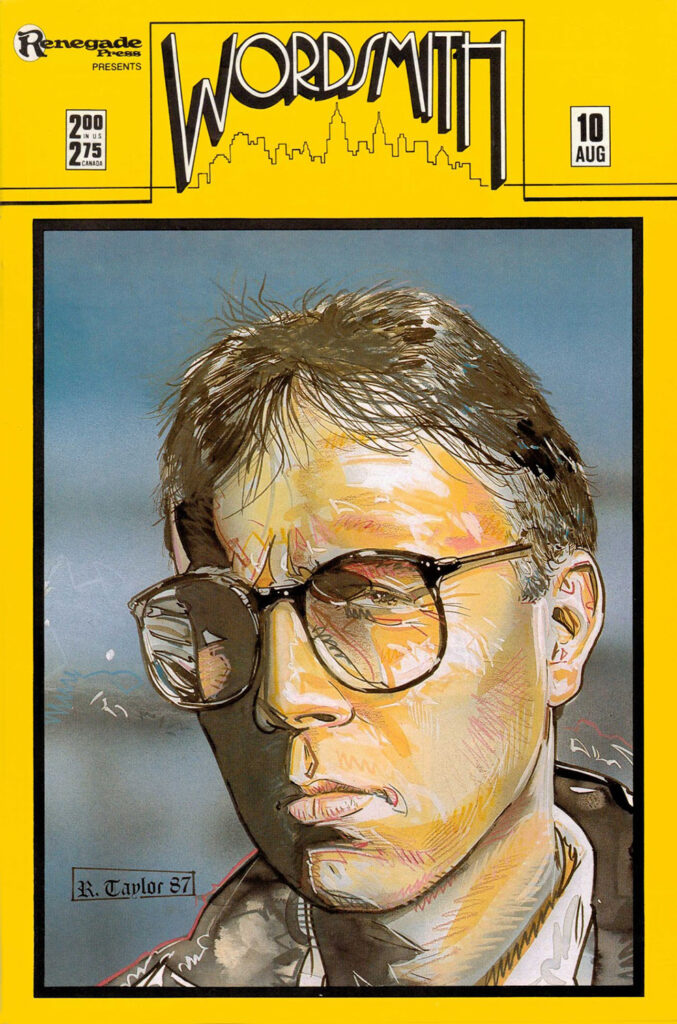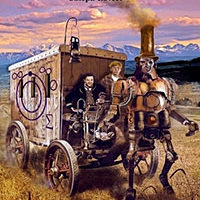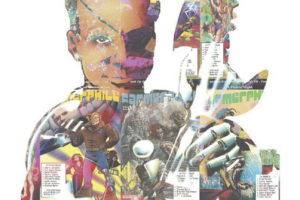I’ve reviewed several pulp comics on this blog, but Wordsmith is probably the most unusual. A product of the 1980’s black-and-white explosion of more alternative comics away from the standard superhero fare that still dominates, I think if this was done today, it would be as a webcomic or a crowd-funded comic.
 Written by Canadian comic writer Dave Darrigo (1954-2024) and drawn by R.G. Taylor, it first appeared as a 12-issue “maxi-series” from Renegade Press from 1985-88. It stars Clay Washburn, a pulp writer in the 1930s and ’40s who writes several serial characters. While we get snippets of several of these characters, it’s Clay’s personal life that is the focus of the comic series. The comic also has a series of non-fiction articles on the pulps by Don Hutchison.
Written by Canadian comic writer Dave Darrigo (1954-2024) and drawn by R.G. Taylor, it first appeared as a 12-issue “maxi-series” from Renegade Press from 1985-88. It stars Clay Washburn, a pulp writer in the 1930s and ’40s who writes several serial characters. While we get snippets of several of these characters, it’s Clay’s personal life that is the focus of the comic series. The comic also has a series of non-fiction articles on the pulps by Don Hutchison.
The series was later reprinted in two trade paperback volumes by Caliber Press is 1990. The first volume had a forward by Will Murray and an afterward by Dave Darrigo, and reprinted his article “Long live the pulps” from the first two comics. The second volume reprinted all of Don Hutchison’s articles. Left out are all the covers and pin-up artwork from the comic book series.
In 1996, Caliber reprinted the series in nine comic books (the whole series was reprinted; several issues were double issues). In addition, there was one issue of Heroes of Wordsmith comic in 1990 from Canadian comic book publisher Diamond Press under their “Special Studio” imprint that presented a story of one of Clay’s characters, the WWI aviator hero Hunter Hawke along with another story of a “modern day” Flying Tiger group set in Africa. Heroes of Wordsmith was planned as a trilogy, but poor sales killed any chance of that.
Frankly, I wish the whole thing would be reprinted, comic stories, pinups, articles, and covers. It could certainly be done as a print-on-demand product easily from someone like Bold Venture or the like. And would be on nicer paper, as these were printed on your standard grade comic book paper which is slowly turning brown.
Of his characters there is Tombstone Tunney, a Western gunfighter and sheriff; Congo Carson, a “great white hunter” and explorer; Brass-Knuckles Bendix is a hard-boiled detective; Hunter Hawke is an aviator hero similar to G-8; the Domino Detective is a masked detective later created to star in his own character magazine; Captain Strong is referred to as a Doc Savage pastiche, but is really more akin to The Skipper; Thunderbolt Bonner is a baseball player for a sports pulp; Freedom Fighter is a government agent fighting fascists, somewhat like Operator #5; and Bart Stover, a G-man.
As the series focuses on the real life of a ’30s pulp writer, at times you see things that as far as I know are true. But at times I saw things that I’m not too sure about. I would certainly be interested in a more critical review of this series in regard to its historical elements. For instance, you see Clay running around to get paid for his work. Most of the pulps paid on acceptance; only the lower ones paid on publication. I would think that Clay with his serial characters would be working for the better publishers.
We only hear of a few real pulp magazines or publishers, though we see a few in the artwork. Street & Smith is mentioned, along with Doc Savage and The Shadow. Black Mask is noted as Clay has tried to crack that market but failed. But it seems all the publishers Clay works for are made-up.
Also, by and large, none of the individuals we meet in the stories are based on real people, other than one in the last issue. For some reason, Clay writes all his works under pen names. But no reason is given for this. Not all pulp writers did so.
We meet Washburn in the first issue as he struggles to finish a Tombstone Tunney story, as well as work on a Congo Carson tale. We also meet Joe, a former boxer who runs the local newsstand, and Gary Arbour, an artist who also does magazine covers. Joe will appear several times in the series.
In the second issue, Clay is working on a Brass-Knuckles Bendix story. However, discussions with his then upper-class girlfriend cause him to make changes in the story, which he isn’t happy with. He later meets up with a former pulp detective writer who has been able to crack the original book market with murder mysteries for some advice. Among other things, he gives Clay his recipe for “newsstand soup”: “a quart of violence, a glass of sentiment, a tablespoon of logic, a dash of chaos, and a pinch of order.” We also see Clay dropping in with a group of communist sympathizers and meeting his poet friend Moses Cohen.
In the third issue, Clay is asked, along with other writers, to create a new hero for a new character pulp. His creation, the Domino Detective, is based on a friend, an Italian-American publisher who is being extorted by the Mafia. But he gets pushback for having an Italian-American hero. The characters proposed by the other writers include The Night Fighter, a cross between the Lone Ranger and Doc Savage, and Mister Mystery who is a crime fighter who is also a warlock. We also meet his adoptive parents.
In the fourth issue, Clay befriends a kid he runs into on the street who is impressed that he’s a pulp writer. Clay soon discovers the boy is an orphan, adopted by an abusive man. He winds up taking him to the orphanage where he was raised until he was adopted. Along the way, we learn about Captain Strong, and in a new story, he creates a character in the next Captain Strong story based on the boy. When he visits the boy, he learns another secret about the boy.
In the fifth issue, Clay finds out about the Nazi party when Asa Cohen, older brother of Moses, is translating Mein Kampf. He later attends a meeting of fellow writers and encounters a Nazi sympathizer who wants to create a “Nazi Doc Savage” (it has been done). His friends think he is overreaching and plan something. Clay is then asked to work on a new magazine as he writes the adventures of Freedom Fighter, a secret agent fighting the fascists. Early on we see him writing a Thunderbolt Bonner story.
In the sixth issue, Clay is out on a date with his high-class girlfriend when he picks up a pulp with one of his latest stories, a “space cowboy” tale in Space Adventures (which was the name of a sf comic book series by Charlton Comics, and they even use the title logo on the fictitious pulp). Needless to say, she is less than impressed. And Clay is working on a Hunter Hawk story. His issues with his girlfriend causes him to ask another author to “ghost” the next Hunter Hawk story for him, while he can concentrate on writing a “serious” novel about an American veteran of World War I. Clay is later introduced to a successful author, hoping for advice or inspiration. Let’s just say things don’t go as expected.
In the seventh issue, it’s coming to Christmas time, and Clay is struggling financially, as several publishers haven’t paid him. (They seem to be paying on publication instead of acceptance.) Clay is working on a new Congo Carson tale but also covers for Joe at his newsstand while he takes care of his ailing wife. And he has a little encounter with the new secretary at Royal Publications, who seems his main publisher. AFAIK, Royal isn’t based on any particular publisher. There was a publisher by that name in the ’50s.
In the eighth issue, Clay deals with both romantic issues and nightmares, while also working on the next Brass-Knuckles Bendix story. His girlfriend kind of invites him to a party she is having, but Clay gets cold feet at the last minute. But a good thing is in a conversation with the editor at Royal, they plan on making Brass-Knuckles Bendix an ongoing feature of one of their magazines. And he has a discussion with the editor of Royal’s romance pulp, who wants more Cupid Carol stories, but Clay begs off.
 In the ninth issue, set in 1936 (I think the first time a date is explicitly stated) Clay is approached by an agent after reading his latest western tale, which we get to read in its entirety, who says he can get Clay better-paying work, even books. Clay is skeptical (though several pulp authors did use agents). His agent wants Clay to specialize in one genre, westerns. But Clay wants to write in several. Again, many pulp authors did write in several genres and did so successfully. So who will win out?
In the ninth issue, set in 1936 (I think the first time a date is explicitly stated) Clay is approached by an agent after reading his latest western tale, which we get to read in its entirety, who says he can get Clay better-paying work, even books. Clay is skeptical (though several pulp authors did use agents). His agent wants Clay to specialize in one genre, westerns. But Clay wants to write in several. Again, many pulp authors did write in several genres and did so successfully. So who will win out?
In the tenth issue, it’s the summer of 1937. Clay is wrapping up a swashbuckler tale. We also catch up with Clay’s friends Moses and Asa Cohen. Moses is planning on heading to Spain to fight the fascists, and Asa and Clay are trying to stop him. Can they succeed? Also, Clay has a new girlfriend, the secretary at Royal he met several issues back. And he learns about these new things called “comic books.”
In the eleventh issue, it’s now 1939. Clay is married, his wife is pregnant, and he’s writing movie screenplays, something that several pulp writers moved into. He is working on getting his first novel published (that one about an American veteran) and is working on his second novel and doing a series of stories about Bart Stover in a G-man pulp. When he finds that his old friend Joe, the former boxer who ran the newsstand, is now sick, he decides to start on a new story about him.
In the 12th issue, it’s now December 1941. War is looming and things are changing. Pulp magazines are cutting back, though I don’t think that happened for a little while. Clay’s first book is out. Strangely, I thought, Clay and some of his friends from the pulps enter the world of comic books. Clay creates a Captain America-esque character in Freedom Fighter. And we get the only cameo in the whole series in Jake Corby, clearly based on Jack Kirby. At the end, Clay moves to Washington, D.C., for a job working for the government.
Now for the non-fiction pieces: Issues #1-2 had “Long Live the Pulps” (book 1) by Dave Darrigo. Issue #2 had “It’s a Jungle Out There” by Don Hutchison, #3 “Father of the Flying Spy” by Don, #4 “Walter Gibson” by Don, #5 “A Visit With a Legend” by Don, #7 “Ten Cent Heroes” by Don, #8 “Man of Tomorrow” by Don, #12 “Pulps are Dead … Long Live Pulp Fiction” by Don, and “Last Word” by Dave Darrigo. The two articles by Dave were reprinted in the first trade paperback collection and all of Don Hutchison’s articles in the second trade.
Overall it’s an interesting series. I don’t think we ever learned about the fate of Moses Cohen. You wonder what happened to Clay after the 12th issue. Did he return to screenplays, maybe moving into TV, again something many pulp writers did? Did he move into books? Or all of that?
As I noted, I really wish we could get a complete Wordsmith collection. It should have all the stories, but also all the pin-up work, the non-fiction articles, covers, and stuff from The Heroes of Wordsmith. With crowdsourcing and print-on-demand this is all doable. But who would spearhead it? I don’t even know if the original creators are still alive or what they are doing. Dave Darrigo was involved with some other comics in the ’80s and ’90s. I plan on posting about one of these once I get all the issues.



